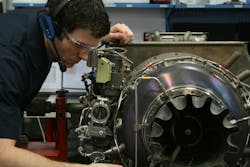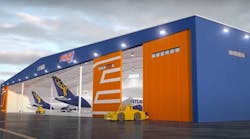We live in a rapidly changing world with numerous innovations being developed to take advantage of new technologies and improve efficiency. Many organizations have dedicated research and development staff focused on innovations directed toward maintenance processes or aircraft operations. Here are just a few interesting examples of how technology has prompted innovation.
Voice Technology for Maintenance and Inspection
Honeywell’s Vocollect System
Workcards and checklists are items maintainers have learned to live with. They’re used on every task every day. It’s a traditional system where instructions are read, followed, discrepancies and measurements recorded, and at the end of the procedure certain steps may be signed-off as verification of accomplishment. As work instructions and manuals have moved more into the digital age, you could ask the question, are written instructions still the most efficient?
Honeywell Aerospace has recently developed an innovative voice technology solution using voice recognition as an alternative to inspection and maintenance written instructions called Vocollect.
According to Honeywell Aerospace’s Joe Stepanski, “Here at Honeywell we continue to innovate and create solutions to better the maintenance industry, and speech recognition is one of those innovative solutions along with things like RFID and glass or sight technology.”
Currently Vocollect has been implemented in several Honeywell MRO facilities for repair and overhaul of APUs, engines, and avionics. Some of the benefits of voice are described to be better quality, standardized workflow, better ergonomics, and a better user experience – the full package.
Here’s how it works. The technician wears a wireless headset and a voice-enabled mobile computing device. Through the company's wireless network the technician is connected to the Vocollect system and the company’s in-house ERP/EAM records system. For example, an APU is received in the shop and the first task is an incoming inspection. The system once activated directs the technician by voice command through the incoming inspection checklist and allows for hands-free, eyes-free voice data entry. The system captures all information through spoken commands. The technician responds to work instructions with answers such as Yes, No, Check, provides measurements when the task requires, and recognizes completion of steps.
The entire conversation is recorded and spoken information is communicated back to the host data system and converted to text on the applicable checklist with real-time updates. The voice commands will even direct a technician to take a video or photos which become part of the documentation.
More information and to view the videos on the Honeywell Aerospace voice recognition system visit www.vocollect.com/inspections.
Robotics for Maintenance and Inspection
Composite Adaptable Inspection and Repair - CAIRE
A research project by Lufthansa Technik called, "Rapid Repair," developed a composite repair process focused on rapid, automated, and reproducible repairs using a robotic milling/grinding device for damage removal and repair preparation. The Rapid Repair project was then followed by another project called Composite Adaptable Inspection and Repair (CAIRE), which provides the original stationary milling/grinding robot the ability to be used in field repairs by mobile maintenance teams.
CAIRE will primarily be used for large surfaces with either solid laminate or sandwich structures. Until now, large areas of damage to these types of composite surfaces generally meant lengthy inspection, diagnosis, and preparation followed by a lengthy repair in a specialized maintenance setting.
The robot is placed on a stand attached to the composite structure or component with suction cups. Specially developed software allows the mobile robot to process 1,000 x 1,000 millimeter surfaces and thick composite structure. The damage is scanned, the surface is modelled, and the form of the scarfing and the milling path are calculated. The robot then grinds out the damaged material. The CAIRE robot is about (add approximate dimensions and weight here)
Mobile Robot for Fuselage Inspection - MORFI
Another robotic innovation by Lufthansa Technik used for inspecting metallic aircraft fuselage structures is the Mobile Robot for Fuselage Inspection or MORFI. The result of a research project called Thermographic Crack Detection (TCD), this mobile robot, equipped with a thermographic probe unit, walks over the outer skin of the aircraft fuselage on defined routes, inspecting the surface for cracks in a shorter period of time than traditional methods. MORFI is fitted with active vacuum pads or suction cups which enable it to move and position itself about the aircraft even on vertical and overhanging sections of the fuselage.
Thermographic crack detection involves heating the area of the fuselage surface to be inspected by a few degrees with a brief electrical impulse. An infrared camera is used to record the heated inspection area in real time. Cracks in the region being inspected have a characteristic temperature profile that clearly differentiates them from the background structure because they heat more than the surrounding area. With the help of analytical software, even the smallest cracks can be made visible and identifiable. More can be found on all the innovation projects at Lufthansa Technik at http://www.lufthansa-technik.com/innovation.



